
| |
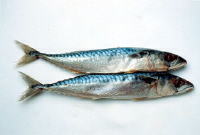
Deadbait, mackerel
One of the most popular pike baits and the best one to try first on a new venue.
Readily available from most good tackle shops, fishmongers and supermarkets and
quite cheap. An oily bait which emits a strong aroma with a tough skin meaning
they can be cast some distance without coming off. A great gravel pit bait. It's
thought the pike might mistake their markings for small jack pike.
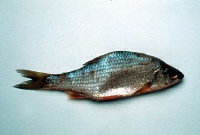
Deadbait, roach
The most natural deadbait which will catch all predators. Freshly-killed small
roach are the best for zander and perch. Slashing the flanks helps the juices
out. Half a roach, either head or tail, is a good eel bait. For pike, choose a
fish matching the average size of the roach in the venue you are fishing. In
clear waters they are great fished sink-and-draw style, hooked with the top
treble through the head and the bottom treble through the flank.
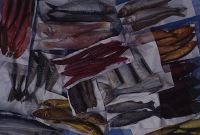
Deadbaits
Dead fish used to catch predators like pike, zander, perch, eels and catfish. As
predators get bigger, they become less agile and less inclined to chase live
fish, turning to scavenging for dead fish on the bottom. Thus deadbaiting is a
good way to try and single out a specimen. Zander and perch will usually not
take sea deadbaits.
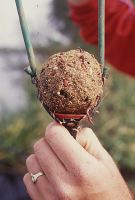
Groundbait
Basically groundbait in its many forms is used to draw fish into your peg and
hold them there. Once mixed (by adding water) it’s either fed in balls by
hand, through a groundbait catapult in balls at distances beyond about 15
metres, or through and open ended feeder as far as you can cast. In its simplest
form, groundbait is dried and crushed bread, called 'crumb', which is available
in white and light brown. Plain brown crumb laced with chopped worms and squatts
is a superb mix to put through a feeder for bream fishing. Things become more
complicated when you move to ‘Continental’ groundbaits. These contain all
sorts of weird and wonderful ingredients designed for use in varying conditions
to attract different species and to behave in all manner of ways. Luckily for
the newcomer the groundbait’s intended use is usually stated on the packaging
- ‘Tench’, ‘Carp’, Feeder’, ‘Cloud’ and so on. The big groundbait
firms - Sensas and Van den Eynde - keep the actual ingredients of their various
mixes secret, and who can blame them? There can't be too many other businesses
where the customer pays £2 for a product which he immediately throws away!
Generalising is very difficult, but before you buy a groundbait you should think
about what you want it to achieve. If, for instance, you are going to try and
catch fish in the upper layers you need a groundbait which breaks up as soon as
it hits the surface and creates a cloud. If you are fishing a fast, deep river
you need a groundbait that binds together well and only start breaking up when
it’s on the bottom. The weather must be taken into account too, and the
condition of the water you are fishing. In winter, venues are often clear and
fish not very active. It doesn’t take much to fill them up and so you need a
fine groundbait and in clearish water a dark mix is best. Van den Eynde
Supermatch or Sensas Noire are excellent. In summer however when fish like carp
are active, you need a groundbait with lots of particles which will keep fish
rooting about in your peg, and a coarse groundbait like Sensas Carp would be
good. You can also get any mix to behave differently just by varying how much
water you add. The drier the mix, the quicker it will break up on contact with
water. Generally speaking, you are looking to create a mix which will hold
together for feeding but will break up close to the bottom. It should be said
that groundbait can be the kiss of death on some venues, especially clear ones
where loosefeeding maggots can be much better. It pays to ask the local tackle
dealer his advice if you are fishing a new venue.
Livebait
Fishing with live fish for predators is not banned by law, but it is frowned
upon by some. However, there are occasions when livebaiting is the only way to
catch, especially on hard-fished venues. Livebaits commonly used include roach
for pike and zander, gudgeon for big perch, and trout on trout reservoirs for
large pike. Trout venues which permit livebaiting only allow you to use live
trout baits sold at the venue. It should be noted that it is illegal to
transport any live fish from one venue to another. This law is in place to
prevent the spread of disease. Livebaits over three inches long are generally
presented on hook traces encorporating two treble hooks, or "snap
tackles" as they are sometimes known. The best are semi barbless, using
trebles with one barbed hook to hold the bait on, and two barbless hooks for
hooking the fish cleanly and unhooking it quickly. They should always be fished
in conjunction with a wire trace as pike can easily bite through mono line and
that would leave treble hooks in their mouth. Small livebaits can be fished with
a large single hook through the lip of the fish. Whilst a deadly method,
deadbaiting is often the way to pick up the largest predatory fish, which have
become less agile and therefore turn to scavenging for food rather than actively
hunting it.
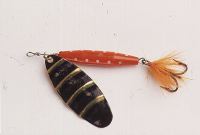
Lures - blade spinners
A metal blade revolves around an axis sending vibrations through the water,
flashing as it goes. They should be retrieved slowly and steadily. Look for
spinners with integral casting weight around the axis. The traditional blade
spinner patterns are typified by the French Mepps and Vibrax patterns and the
ABU 'Droppen' and 'Reflex'. Sizes range from 0 to 4 on the Mepps size system (up
to about 15gm) and blade colours are usually metallic silver, gold, copper or
black, either plain or decorated with spots or stripes of various colours. Mepps
in the smaller sizes (00 to 1) are fabulous perch and chub catchers, with larger
sizes good for zander and small pike and game fish.
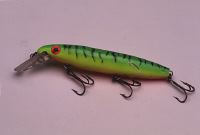
Lures - floating divers
Plastic/wooden lures which float until you start winding in, when the lure
starts working underwater at a depth governed by the vane at the front and speed
of retrieve. A large, low-angled vane indicates a deep diver, a smaller,
sharply-angled vane signals a shallow working plug. Fished by varying the speed
of retrieve, which makes the lure wobble and work from side to side, and called
‘crank baits’ in America. Good floating divers include the Rapala Shad Rap
and the Shakespeare Big S.
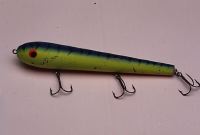
Lures - jerkbaits
Large, specialist, wooden lure designed to catch big predators. Fished with
short, powerful rod and heavy braid. The angler puts most of the action into the
lure by ‘cranking’ hard. Can be floating, sinking or shallow diving.
Expensive and not one for the beginner.
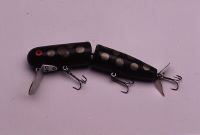
Lures - sinking divers
These are plugs which sink when cast in, so they are easy to lose! the depth
they work at depends on how long you allow them to sink and how fast you
retrieve. Can be jointed. Good for deep water venues like gravel pits and
reservoirs. A famous sinking diver is the Creek Chub Pikie, the lure which
caught the British record pike.

Lures - spinnerbaits
These don’t look like anything alive, but they catch lots of fish. They were
developed in the US for freshwater bass but catch plenty of zander and pike
here. The real beauty is that they move along with the large single hook
pointing up, and so can be bounced slowly along the bottom without fear of
snagging up, making them great in snaggy swims or for winter fishing when fish
are more docile and tend to rest up on the bottom. With their brightly coloured
‘tails’, they are also a good choice in slightly-coloured water.
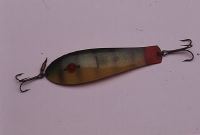
Lures - spoons
Basically spoons are a piece of metal with a hook at one end and a swivel at the
other. They cast well, and wobble on the retrieve like an injured fish,
reflecting the sunlight as they go. Good for covering a lot of water and should
be retrieved at various depths by varying the speed all the time. Top spoons
include the Kuusamo Professor. In traditional salmon fishing, an alternative to
the Devon types of lure is the wobbling bar spoon typified by the ABU Toby and
the Blair/Harkin patterns. Fished in much the same way as Devons, spoons do not
require the same anti-kink measures as they are supposed to wobble and flutter
rather than spin. They are fished in sizes from about 2.5 inches to 5 inches and
up to about 30gm. Colours are typically plain silver, gold, copper (or
combinations); or black/gold 'zebra' stripe, or blue/silver combinations.
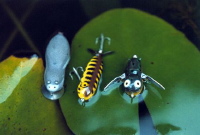
Lures - surface plugs
Plastic or wooden lures which float and work on the surface creating havoc as
they go. Also knows as ‘poppers’, these catch a lot of pike and are great
fun fished in shallowish, clear venues close to weeds and reeds. Takes are
usually spectacular as the fish crashes through the surface layers as it takes
the fish. Most don't look like anything a pike would normally eat, but all the
predator sees is a silhouette on the surface and they probably think they are
attacking a duckling, frog or water vole. They often have great names like the
Heddon Crazy Crawler, Jitter Bug and Heddon Zara Mouse.
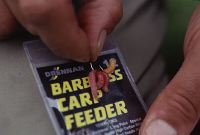
Maggots
The larvae of the bluebottle. Bronze maggots are especially popular for river
fishing, red is excellent for perch and white is the best colour for big roach.
The larger the black spot near the point of the maggot, the fresher and better
the bait. Sold in pint, half pint and quarter pint measures and the tackle
dealer should add a flour-like fine maize to the maggots to degrease them so
that they sink faster. Maggots should be hooked by lightly piercing the blunt
end just through the skin. Hook size 16-20.
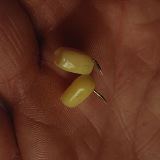
Sweetcorn
Cheap, popular summer bait which can be used straight from the tin and loved by
big fish, in particular carp, barbel and tench. Ready-flavoured and coloured
brands are available so you can use anything from red, strawberry flavoured
corn, to orange Tutti Frutti corn. Liquidised corn also sold in tins, but the
unflavoured variety straight from the tin is hard to beat. Should be hooked so
the point shows through the skin. Good for pre-baiting and the sweet juice can
be added to the water you mix your groundbait with. Hook size: one grain on a
size 16, two on a 12 etc.
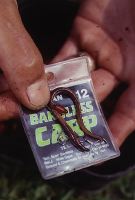
Worms - dendrabaenas
Medium-sized worm and the cheapest to buy. The best worm for chopping up and
feeding neat of with casters for perch or in groundbait when bream fishing. For
the hook it's best to fish a one ot two inch long piece of a dendra, hooking at
the cut end. Hook sizes 10-16. Very small pieces of dendras can be superb for
skimmers.
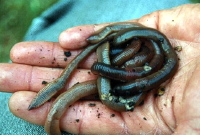
Worms - lobworms
An excellent floodwater bait for big river fish like chub and big roach. Can be
collected at night from lawns on a wet night. Injecting air into the head of the
lobworm above the saddle pops it up enticingly off the bottom - a very good
method for big perch. Hook through the head. Hook sizes 6-10.
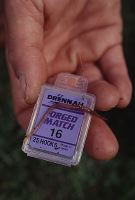
Worms - redworm
Quite easy to collect from compost heaps, the redworm is a first class bream
bait when tipped with a maggot or caster. Triple world champion Bob Nudd likes
to hook these by cutting in half and hooking through both cut ends, theorising
that the fish home in on the cut (hook) end which is letting out all the lovely
juices. Hook sizes 14-18.
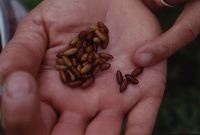
Casters
The chrysalis stage before a bluebottle maggot becomes a fly and a particularly
good bait for picking off bigger fish. When maggots first 'turn' the caster's
shell is pale and the caster sinks, but it turns dark when left in open air and
becomes a 'floater'. They can be stopped from turning into floaters by being
kept in water or sealed in an air-tight bag. Casters should be threaded onto the
hook through the blunt, tail-end resulting in a "buried" hook and
superior presentation. Alternatively if the fish are feeding freely the caster
can be hooked in a similar fashion to the humble maggot. Hook size 16-18.
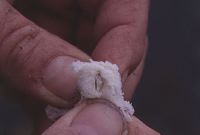
Breadflake
The fresh, white flake from an uncut loaf is a wonderful big fish hook bait,
especially on chub, dace and big roach rivers in winter, and also for mullet in
harbours and estuaries. Just fold a pinch around the shank of a size 8-14 hook
and squeeze to clamp it in place, making sure the hook point is showing and that
it’s still ‘fluffy’ around the bend of the hook. Fished with mashed bread
as feed and best when there is just a touch of colour in the water. The hook
bait should be struck off at the end of each cast to keep feeding the swim
gradually.

Feeder fishing: Paternoster rig
Classic bream rig
A vast number of bream anglers prefer using a
paternoster rig when legering. It’s a simple rig and, because there are no
swivels or beads linking mainline to hooklength, it is very resistance-free to
taking fish. There are a couple of rules to adhere though. Firstly the length
between the four-turn water knot and base of the feeder must be shorter than the
length between four-turn water knot and the hooklength knot. This helps prevent
tangles. Secondly, the paternoster link must be made up using line of a lighter
breaking strain than the mainline. If you were to snag the feeder and have to
pull for a break the paternoster link would snap first. The snap swivel allows a
quick change of feeder is you need to step up, or down, on the feeder or switch
to a bomb.
|
